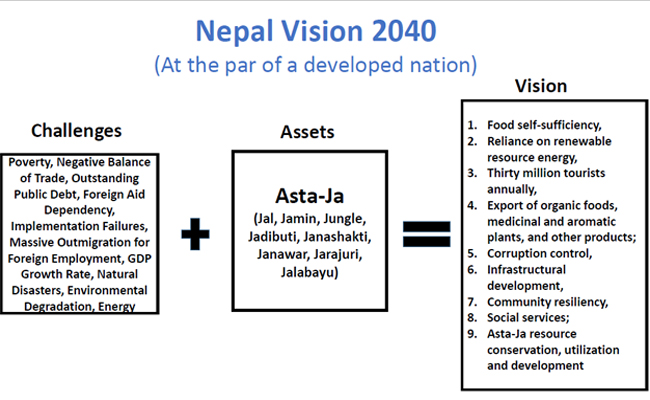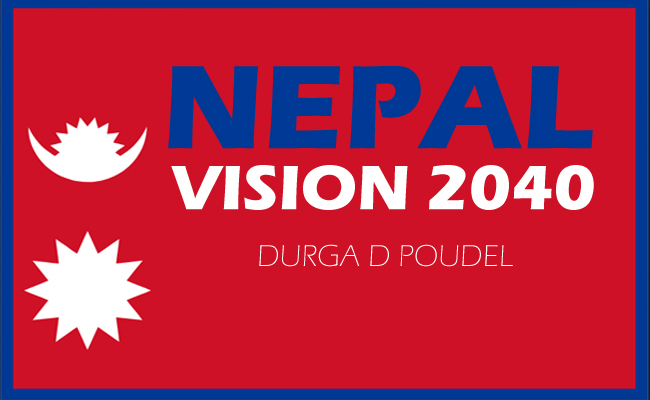While King Birendra’s pledge for raising the living standard of Nepalese people to the “Asian level” by 2000 (Baral, 1987) drew some attention in the past, there have been some exercises lately for developing vision for Nepal (Sharma et al. (eds.), 2012; NPC-ADB, 2016). Sharma et al. (eds.) (2012) presented a quite elaborative discussion on vision for Nepal in their book Nepal 2030: A Vision for Peaceful and Prosperous Nation. The ten chapters of this book cover the areas of land, tourism, hydropower, use of science and technology, transportation, water resources, overall security, women’s empowerment, agriculture, climate change, and education as the focus areas for Nepal 2030. In order to come up with Nepal’s long-term developmental strategy, the NPC with the help from Asian Development Bank (ADB) hosted a one-day high level international seminar, the “Envisioning Nepal 2030” on March 28, 2016, in Kathmandu, which was attended by representatives from government agencies, private sector, aid agencies, academia, civil society organizations, and other stakeholders (NPC-ADB, 2016). With the goals of graduating from LDC status by 2022, achieving SDGs, and becoming a middle-income country by 2030, various thematic presentations made in the seminar included accelerating inclusive growth, energy (hydropower) development, urban development and transport connectivity, human resource and social sector development, and transforming agriculture into a high-value competitive industry.
About a decade ago, Poudel (2008) founded a groundbreaking Asta-Ja Framework for nation-building and socio-economic transformation of Nepal. Asta-Ja Framework includes eight “Ja”, Nepali letter “Ja” [Jal (water), Jamin (land), Jungle (forest), Jadibuti (medicinal and aromatic plants), Janashakti (manpower), Janawar (animals), Jarajuri (crop plants), and Jalabayu (climate)] and eight principles (community awareness; capacity-building; policy decision making; interrelationships and linkages; comprehensive assessment; sustainable technologies and practices; institutions, trade, and governance; and sustainable community development and socio-economic transformation) (Poudel, 2016). Based on Asta-Ja Framework and Nepal’s current socio-economic and environmental challenges, Nepal Vision 2040 is developed (Figure 1). Nepal Vision 2040 aims elevating Nepal at the par of a developed nation by 2040. Discussion on goals and strategies of Nepal Vision 2040 follows.
Food Self-Sufficiency:
 Nepal has been aiming for self-sufficiency since its First Five-Year Plan (1956-61), when its major exports included jute products, rice, wood, medicinal herbs, bamboo, and sabai grass, and major imports included textiles, sugar, cement, and cigarettes (Consing, 1963). For import substitution, the U.S.S.R. and China assisted Nepal by establishing sugar, cigarette, and cement factories as early as in 1960s. However, despite high potential for food self-sufficiency, Nepal has been importing wide range of agricultural products in recent decades. Major agricultural commodities imported in 2014/2015 included cereals (Rs. 35.12 billion), fat and edible oil (Rs. 22.51 billion), vegetables (Rs. 15.93 billion), fruits and nuts (Rs. 10.54 billion), animal fodder (Rs. 10.02 billion), oil seeds (Rs. 9.11 billion), coffee, tea and spices (Rs. 4.27 billion), sugar and confectionery (Rs. 3.49 billion), beverages (Rs. 2.92 billion), tobacco (Rs. 2.55 billion), live animal (Rs. 2.42 billion), dairy products (Rs. 2.15 billion), and fish (Rs. 1.15 billion) (CBS, 2016b). Of cereals, rice and paddy constituted Rs. 23.79 billion (684,130 MT) and maize Rs. 7.43 billion (290.993 MT). More than 95 percent of rice and paddy and maize imports came from India.
Nepal has been aiming for self-sufficiency since its First Five-Year Plan (1956-61), when its major exports included jute products, rice, wood, medicinal herbs, bamboo, and sabai grass, and major imports included textiles, sugar, cement, and cigarettes (Consing, 1963). For import substitution, the U.S.S.R. and China assisted Nepal by establishing sugar, cigarette, and cement factories as early as in 1960s. However, despite high potential for food self-sufficiency, Nepal has been importing wide range of agricultural products in recent decades. Major agricultural commodities imported in 2014/2015 included cereals (Rs. 35.12 billion), fat and edible oil (Rs. 22.51 billion), vegetables (Rs. 15.93 billion), fruits and nuts (Rs. 10.54 billion), animal fodder (Rs. 10.02 billion), oil seeds (Rs. 9.11 billion), coffee, tea and spices (Rs. 4.27 billion), sugar and confectionery (Rs. 3.49 billion), beverages (Rs. 2.92 billion), tobacco (Rs. 2.55 billion), live animal (Rs. 2.42 billion), dairy products (Rs. 2.15 billion), and fish (Rs. 1.15 billion) (CBS, 2016b). Of cereals, rice and paddy constituted Rs. 23.79 billion (684,130 MT) and maize Rs. 7.43 billion (290.993 MT). More than 95 percent of rice and paddy and maize imports came from India.
Nepal’s total food production in 2016/17 fiscal year was estimated at 9,741,000 MT, which included 5,230,000 MT paddy (rice), 2,320,000 MT maize, 1,841,000 MT wheat, and 306,000 MT millet (MoF, 2017). Compared to the previous fiscal year 2015/16, total estimated food production and the estimated production of rice, maize, wheat, and millet in 2016/17 increased by 13 percent, 21.6 percent, 3.97 percent, 6 percent, and 1.26 percent, respectively. Timely onset of monsoon and timely availability of fertilizers and improved seeds were the primary reasons for this yield increase. A close look of food production statistics and the fact that more than 4.26 million hectares of agricultural land with very suitable agro-ecology for agricultural production and 69 percent of total population engaged in agriculture, food self-sufficiency is not a difficult goal to reach. Crop yields can be increased significantly through adequate irrigation facilities, high yielding varieties, timely availability of necessary agricultural inputs, and appropriate crop production technologies. Food storage facilities and controlling food losses during storage will also significantly add to food self-sufficiency. Various programs including Agricultural Development Strategy (ADS) and initiatives such as the Food Security Action Plan, the Zero Hunger Challenge Initiative 2025, and the Multi-Sector Nutritional Plan (Kyle and Resnick, 2016) will potentially contribute to food self-sufficiency. As the 2015 Constitution devolves power from the Ministry of Agriculture Development (MoAD) to provincial and local governments for agricultural and livestock production, it is important for the central government to coordinate these activities across the nation effectively and allocate funds accordingly.
According to Chapagain (2017), Nepal is currently producing 914.18 MW of hydroelectricity followed by 53.41 MW from thermal plant and 0.68 MW from solar power. In 2014/15, electricity imported from India comprised 27 percent of Nepal’s total energy supply. The Ninth Five-Year Plan (1997-2002) had emphasized the development of large hydroelectric projects so that Nepal would not only be self-sufficient in energy but also would export energy to neighboring countries. Major hydropower projects envisioned during the Ninth plan included Koshi 4,700 MW, Karnali 10,800 MW and Mahakali 4,680 MW. While it is estimated a GDP growth rate of >8 percent is necessary to graduate Nepal from the list of LDCs, even for a modest GDP growth rate of 5.6 percent Nepal needs additional 11,500 MW of electricity by 2030 (Lacoul, 2015). According to Chapagain (2017), Nepal’s total demand for electricity will reach 6,000-11,000 MW by 2025 and 20,000-51,000 MW by 2040. With current capacity of 2,954 MW, there is obviously a serious future deficit of electricity in Nepal. Alternative energy sources such as solar, wind, and biofuel can augment energy production. Just as Bhutan has a plan to reduce the use of petroleum products by 70 percent by 2020 (Adhikari, 2015), Nepal should accelerate generation of hydropower and start utilizing electricity and alternative energy in households and other uses.

Thirty Million Tourist Annually Nepal’s tourist arrival in 2016 was 753,002 and total revenue generated from tourism was $518,498,000 (MoCTCA, 2016). In 2016, seventy-six percent of tourists arrived by air, and the top five countries providing tourists were India, China, Srilanka, USA, and UK. There were 82,830 tourists for pilgrimage. Nepal’s tourism infrastructure in 2016 included 38,242 beds with 120 star and 985 non-star hotels, 3,444 travel agencies, 2,367 trekking agencies, 3,717 tourist guides, and 13,049 trekking guides. By learning lessons from Thailand, Nepal can attract at least 30 million tourist annually. Thailand had 10.8 million tourist arrival in 2002, which reached to 32.58 million in 2016 (Thaiwebsites, 2017). Major countries providing tourists to Thailand included China, Malaysia, Japan, Russia, Korea, India, Australia, Laos, UK, Singapore, USA, Germany, Vietnam, France, Hong Kong, Indonesia, Combodia, and Taiwan. China was far ahead of Malaysia, the second largest tourist providers. According to Agoda Company (2017), there are at least 50,924 vacation rentals and hotels available in Thailand. Taking Thailand’s tourism industry as a reference point, Nepal needs more than 1.5 million beds with about 4,800 star and 39,400 non-star hotels to accommodate 30 million tourists annually. There will be a tremendous growth on trekking agencies, including tourist and trekking guides. With the current rate of revenue generation, 30 million tourists will add more than US $20 billion annually to Nepalese economy. The vast Himalayan range with beautiful Mountain and Terai landscapes can serve as the major tourist destinations for the world. Along with conventional tourism, Nepal must focus on eco-tourism and religious tourism.
Export of Organic Foods, Medicinal and Aromatic Plants and Other Products:
Located between two large countries, India and China, Nepal has great opportunities for production and export of high-value products including organic produce, medicinal and aromatic plant products, bottled drinking water, electricity, and other high-value commodities. Presence of unique agro-ecological zones, naturally isolated production belts, smallholder and mixed farming production system, and the existence of traditional knowledge for agricultural production favor organic production. In fact, Nepal should consider declaring both the Mountainous and Himalayan regions as organic production belts in the first phase and then whole nation later. Nepal can serve the world as a global refuge for organic agriculture. Specialty products such as honey, cardamom, tea, coffee, medicinal and aromatic plants, vegetable seeds, flowers, organic meat and dairy, tea, coffee, fresh vegetables, and fruits are some products that possess high potential for organic production and export. Despite Nepal being a sovereign country and friendly neighbor for India and latter being one of the major countries helping Nepal for economic development, Nepal’s relationship with India frequently gets strained (Levi, 1959; Gaige, 1971; Lohani, 1975; Ojha, 2015), which is not helpful for both countries in gaining peace, prosperity, and mutual respect. Currently, Nepalese trade is suffering from declining export, shrinking industrial sector, swelling demand prompted by foreign remittances, lacking quality products for exports, lack of trade related infrastructures such as road and electricity, lack of business conducive environment, and lack of appropriate incentives for export promotion (Ghimire, 2016). Therefore, while improving its trade competitiveness, Nepal should fully utilize existing various trade agreements and trade opportunities such as Trade and Investment Framework (TIFA) that Nepal has signed with USA, BIPA agreements that Nepal has signed with other countries, the “Everything but Arms” initiative of European Union, Nepal-India Free Trade Treaty, and growing market in China. The trans-Himalayan air route agreement signed between Nepal and China in 1978 (Baral, 1979) sets the stage for expansion of air transport system of the country.
Corruption Control:
Corruption includes several monetary and non-monetary form, including bribery, fraud, embezzlement, extortion, favoritism and nepotism. According to Transparency International (2017), Nepal ranked 131 out of 176 countries in 2016 Corruption Perception Index. Corruption has infested almost all sectors of the country including public, political, private, judiciary, civil service, police, army, and NGOs (Poudel, 2011). The Commission for Investigation of Abuse of Authority (CIAA), Commission for Investigation of Abuse and Authority Act, 1991; Revenue Leakage (Investigation and Control) Act, 1995; Corruption Prevention Act, 2002; Good Governance (Management and Operation) Act, 2007; and Anti-Money Laundering Act, 2008, include the main constitutional arrangements and corruption control measures in Nepal (Poudel, 2011). Major reasons for uncontrolled corruption in Nepal include failure in the implementation of anti-corruption measures, inadequate laws and regulations, and the lack of institutional capacity for enforcement. In addition to successful implementation of anti-corruption measures, converting Nepal into digital economy and strong presence of anti-corruption institutions and authorities across the nation will help in corruption control. Additionally, a requirement of a financial transaction through bank checks, money orders, or bank transfers will be helpful in controlling corruption. Along with a high degree of coordination among the anti-corruption authorities and institutions such as CIAA, OAG, Vigilance Center, Special Courts, Judicial Council, Army Special Court, Public Media, and other stakeholders, strict enforcement of anti-corruption measures in private sector and in international transactions is necessary.
Infrastructural Development:
Infrastructural development such as construction of roads, airports, irrigation canals, ropeways, hydropower stations, and the establishment of agro-industries incur heavy expenditures. However, such projects directly influence local communities through employment opportunities, market access, and production of goods and services. According to Wildavasky (1972), infrastructural development plans must state clearly, why and where and how, these investments are justified. Unprecedented delay on the completion of construction projects has become a major problem in Nepal. Along with some administrative hurdles, rampant corruption, impunity, political malpractices, negligence, and construction syndicates are responsible for delayed completion of construction projects. Establishment of Nepal Army Corps of Engineers for construction, supervision, and the maintenance of large construction projects will expedite infrastructural development in Nepal. Such projects may include large hydropower, transportation, bridges, reservoirs, irrigation, mining and extractions, flood control, civil aviation, or diversion dams. Private sector can be involved in medium to small size projects. The practice of involving army in developmental activities is not a new one. Involvement of Iranian army in literacy program for decades or the frequent engagement of Indian army in infrastructural development works, and, although during the conflict time, the introduction of the ISDP (the Integrated Security and Development Program initiated in 2001) in Nepal (Gordon, 2005) demonstrate the fact that the concept of Nepal Army Corps of Engineers is not unrealistic.
Community Resiliency:
Community resiliency entails building communities that are less vulnerable to the impacts of natural disasters such as earthquakes, floods, hurricanes, tornadoes, landslides or climate change. Nepal is currently facing historic rebuilding challenges following the devastating 7.8 Magnitude Gorkha Earthquake on April 25, 2015 which took the life of more than 9,000 people injuring more than 19,000 and a complete loss of more than half million building structures affecting more than eight million people. Adverse economic impact of the Gorkha Earthquake coupled with the economic blockade by India is evident by the overall GDP growth rate of 0.01 percent along with the growth rates of 0.03 percent and 0.16 percent, respectively, for agriculture and non-agriculture sector in 2015/16 fiscal year (MoF, 2017). Another natural disaster, the 2017 Terai Flood, has reportedly caused a total loss of more than Rs. 63 billion destroying 41,000 houses completely and damaging 151,000 houses partially. An estimated cost for the recovery of the 2017 Terai Flood is Rs. 73 billion. Additional natural disasters of high magnitude that occurred within in the past 25 years in Nepal include the devastating flood of August 2014 in western Nepal and the 1993 landslides and debris flow (Poudel, 2016). Increased investment on infrastructures such as communication system, early warning system, flood control, evacuation routes, etc., and income diversification, and community capacity-building is necessary for developing resilient communities against natural disasters and climate change impacts.
Social Services:
Nepal has many complex issues and challenges on social service sector mainly education, health, drinking water, support for vulnerable groups, and pollution control. Streamlining Nepalese education system so that it comes within the reach of every citizen while advancing to a higher level of education and research is a critical task. A high degree of disparity exists among Nepalese population with regard to health services mainly due to remoteness, lack of infrastructure, lack of health services facilities, socio-cultural traditions, and gender relations (Campbell et al., 2003). Due to pollution and drying springs, both the quantity and quality of drinking water supply has emerged as a major challenge in recent years (Shrestha et al., 2013; Poudel and Duex, 2016). Many women, children and other vulnerable groups are in dire need of help for food, nutrition, clothing,
education, health services, and other necessities. Old citizens under these poverty-stricken groups are seriously lacking basic social services. Girl trafficking is another major social problem in Nepal. War victim children, handicaps, and disadvantage population need immediate help. Similarly, there is a large landless population in the country who need immediate help. Natural disaster victims from 2015 Gorkha Earthquake and 2017 flood need help and recoveries immediately. As many children in the rural areas lack foods, implementation of school meal programs including food stamps and other food support systems is urgently needed. Women empowerment programs such as providing training and loans for women should have high priority. A large population living in the slumps, landless people, disadvantaged population due to caste system and other differences, and population living in geographically remote and isolated areas need governmental support for basic education, health, employment, food, shelter, and income generation.
Asta-Ja Conservation, Utilization and Development:
Nepal should give high priority for sustainable utilization, conservation and development of Asta-Ja resources. There have been massive degradation of agricultural resources due to soil erosion, deforestation, land use changes, and soil fertility decline (Khadka, 1988; Poudel, 2015). Programs such as soil and water conservation, forest conservation, reforestation, and conservation of medicinal and aromatic plants are necessary for overall development of natural resource base in the country. Springs rejuvenation, rehabilitation of degraded Chure lands, reforestation of degraded areas, and stream bank reinforcement include additional conservation programs that the nation needs to implement immediately. Global warming, climate change impacts, chemicals and pesticides in the environment, soil and water pollution, food contamination, and environmental degradation are major environmental and public health problems of the nation. Different approaches for Asta-Ja conservation, development and utilization include community involvement, collaborative undertakings, private businesses, or governmental initiatives. For the best utilization and the conservation of Asta-Ja resources, Nepal must immediately launch large-scale training programs leading to a widespread income generation and resource conservation activities across the nation. According to Khadka (1988), there must be high commitment, dedication, and seriousness in the part of politicians and the government for successful implementation of development plans and strategies.
The Tenth Plan (2002-2007) (NPC, 2003) identifies three essential requirements for program success:
(1) political stability;
(2) strong governmental commitment and political will; and
(3) good governance ensuring service delivery, accountability, and transparency.
(PS: Next part of the article will be on Restructuring National Planning Commission)

